Crtd 15-11-06 Lastedit
20-12-27
Bert reads Einstein
Finding Special Relativity on Utrecht University Campus
|
This blog describes why I always wanted to study Special Relativity theory
and my personal practical vicissitudes in the 2 months I did it. For how since
this adventure and understanding it I explain the theory to myself see Bert
Reads Einstein [math] and [exercise].
|
After recently finishing the part of Musil's Der Mann Ohne
Eigenschaften that I had set out to relate [see
my Musil relation], I
had promised myself to finally acquire understanding of relativity theory, probably
because Musil's protagonist Ulrich's last career disappointment had been
... mathematics! That was just a few days before the day where Musil's
book starts: for the first time a horse had had been called a "genius" in a newspaper
which had prompted Ulrich to abandon his highly promising university math post with
immediate effect. He was 32, very good at it, known in the literature for some
results. Though it is not mentioned, the profile Musil gave to Ulrich's
character leaves no doubt he studied and understood relativity theory: it was new
at the time, the entire educated public was aware of it, it
gets mentioned in Der Mann, and Ulrich was trained to read such stuff. But then came the
horse-genius. At the start of Musil's book,
Ulrich had lost his very last jealousy and
ambition and, now firmly aware of the ridiculous state of man, from small to
great, and his history, took time off to search back in Vienna for purpose,
albeit with a worryingly blank notebook.
Not me at the time I first read Der Mann (I was 31). I would need quite a bit more time
than Ulrich to loose my
social career ambitions.
In my early twenties while in my study in logic of scientific
theories, I had done some quick searches in relativity theory, for there it was often referred to in awe as the
best specimen of science, after which illustrations invariably got taken from
simpler theories like Newton's mechanics. Those were hard enough for me to
transfer to mathematical economics, where logical analysis of theory structure,
at the time, had only scarcely and crudely been exercised. I went into that.
In 1913, while Einstein was engaged in publishing his general
version of relativity theory while few yet had understood the previous, very
simple, first version, Mann-character top Austrian Imperial government
dignitary Graf Leinsdorf on a tense moment in the middle of the book shouts: "This psychoanalysis and relativity
theory or how you call all that crap, it bubbles up irresponsibly, and does not
care for the larger social consequences! ... we quickly knock something together
and before we even started to look whether it is something viable we are already
engaged with the next, or even missed the whole thing! A piggery!". Of course
these zillions of petty Freudian therapists setting out to cheat us for good
money indeed were all pigs, and I can't help
thinking of those cats and dogs of new
Microsoft Windows versions raining on us. And more.
His Serene Highness Count Leinsdorf sure had a point.
He led me again to aspire understanding relativity theory,
though a case in which the count's eruption
misses the point completely - and Musil no doubt was fully aware of that.
But I had no time: my head, in 1982, was
fully occupied with my dissertation that a year later caused, to my total surprise, a row
among the midget economics professors of Amsterdam University and then
got read by nobody, at least nobody serious - probably no reason for the world
to mourn, though it is excellent, original and could have helped the intelligent
mathematical economist to efficiently order his procedures - but I can't claim
that could have prevented a disaster, since there was none about to happen. I had gone
into it out of personal curiosity. No wonder the need for my results was not widely felt, though
in physics there was interest in this type of work, and even in the economic
academics of
the
years after quite some young talented successful career scholars joined the
fashion of what got called "economic methodology". However, they lacked the formal training to deal with my stuff, and
were not prepared to acquire it. A
career "methodologist" aspires to talk with academic economists, that's where money
and career are, not in founding a new obscure field for a new class of
insiders rarely deemed of interest by their research objects: mathematical
economists.
But I am still remembering with pleasure the making that analysis,
starting when 25
years old, with a university salary that I totally failed to consume, a 25%
teaching load and no publication pressure to threaten the quality of my work.
|

... my summer 1982
first reading (it looks I've just started!) of Musil's
Der Mann ohne
Eigenschaften (got into it through Wittgenstein's
Tractatus
Logico-Philosophicus by Ulrich's contemporary Viennese Ludwig Wittgenstein
parts of whose personality strongly remind of Ulrich). Meanwhile I wrote my dissertation on dynamic logico-mathematical
analysis of economic theories (published as
Neoclassical Theory
Structure and Theory Development, Studies in Contemporary Economics, Vol. 4,
Berlin, Heidelberg, New York, Tokyo: Springer Verlag, 1983 ...
|
The huge admiration in logic of science for
relativity theory surely
was caused by its overturning of a very admired and totally established
general
theory of physics, Newtonian mechanics, replacing it with something looking very
weird to the ordinary eye which nevertheless yields, in a simpler way, more accurate predictions
and descriptions of physical processes.
In the nineteenth century, the prediction and description problems
of Newtonian mechanics had increased with the increase in the number of ways and of
the accuracy by which one learned to measure not only body movements, but especially
electricity and light. A proliferation of imperspicuous
and unsatisfactory special laws and corrections to match theory with measurement
began to cause more and more headaches and frustrations among theoretical
physicists: physics was in danger to become an unordered toolbox of partly
irreconcilable theories!
Roughly the choices were to 1)
hope for piece by piece reduction of the chaos by harmonizing the worrying
amount of anomalies one by one, 2) to concede that our way to measure meters and seconds does
not result in the identical quantities for
every method of measuring physical processes, that is, to concede that
when meters and seconds in a system are measured from another system that
moves, they are meters and seconds of different lengths. This absurd
second option to straighten the growing mass of measurement "errors" out
(implying they were no errors after all) turned out, in the end, to win the
race.
First, as so often in such cases, the idea was proposed by a young
eccentric outsider who had tried but failed to find a
living in the academic world. After all, universities were originally
founded to maintain tradition, and even today do so, up into the wearing of those
ridiculous black guild suits of three centuries ago. Universities, the only
guilds left! We should be happy that this outsider
wrote a century ago, since nowadays it would have been hard to find people
willing to consider such a very strange and difficult solution of a puzzle. There
are so many of those fools with weird thoughts aren't there? And we have no more time nowadays to
read other people's thoughts: we have to publish!
Many influential career physicists opposed relativity theory so
vigorously that even 16 years after the start of relativity theory they managed
to have Einstein's Nobel prize ascription redrafted to exclude relativity theory
(an illustrative case of a guild-like network, as still regularly operative today, of
professors with more power and influence than brains - but already in the 17th
century Huygens (in Zedeprinten) and others complained of "gepromoveerde ezels" ("PhD donkeys"). They
still abound and did so at the time Einstein's ideas came out. But despite the extremely restrictive conditions of
the first version of relativity, these Heroic Defenders of the Traditional
Standards of the Guild lost the battle, due to overwhelming success of relativity in applying to many
cases with far less need for cumbersome special corrections to make things fit.
But, more spectacular, it yielded some
astronomical predictions totally alien to the Newton-type of thinking that got
dramatically corroborated and reached the world press. Soon,
relativity theory did
better in quite some applications than Newtonian mechanics in describing lots of processes involving
speeds in the order of the speed of light. Those are areas way off the public domain, only known to
specialist physics experimenters, and were even more so in Einstein's early
life, when mankind still predominantly relied on the power of the horse (in the first World
War 8 million horses died). In such everyday processes
relativity should be better than Newton as well, but
measurement in Einstein's days had by far not yet reached the precision required to measure the
difference, and once it finally started to do so, these differences were, usually, only of
interest to experts. But today, with caesium clocks, even time dilation during
ordinary long distance air flights shows.
My good luck was to find an emeritus professor of physics in the
12footdinghy
racing competitions, so I could get some help collecting the literature and
solving problems. But I got no answer that enabled me to pass the graph below in a popular exposition
of relativity theory (Einstein, A.,
Uber die spezielle und die allgemeine Relativitätstheorie,
Braunschweig: Vieweg 1956, orig. 1916). It is used to explain the fundamental Lorentz transformation.
The most simple case even. The math is easy, but I got
no clue whatsoever what he was talking about: space and time shift relative
to the objects moving around but the speed of light is assumed constant,
that is, the same if measured
from whatever object (planet, space vessel) moving with whatever speed in
whichever direction.

...
Lorentz-transformation. This was most of what Einstein needed for his first
(1905) revolution ...
... but what does it mean? ...
I did not see the light, literally: I failed to see how light was meant to move
through this graph. I might need a real teacher.
Help!
Utrecht University is a twenty minutes drive from my
Linge
river shore site. Its web site turned out to be, excuse me, a bit
of a disaster. Paddling around a
home page that was aggressively trying to divert my attention to a "virtual sleeping coach" and an
"anti-teasing program", in the end I found a course
name "mechanics", but could not find the address of the offices of the
physics staff, nor the material to be studied, the lecture rooms and times of service.
I took my car to head for the "Uithof".
At the entrance of the large university campus a signpost encouraged me to
navigate on the name of the street I wish to reach. A bit discouraging for I had
come in search of it.
"Physics"? To the university security officer engaged in writing number plates of illegally parked cars
that word
did not ring a bell, but he gave me a quarter of compass that held, in his
opinion, an above-average chance.
I managed to park. Legally. Took my foldable bike, entered a building. Its signpost featured the building's name,
that of a person, not related, as far as I know, to any academic field. It did
not list or say
what was inside. An exiting student apologized for not knowing
the whereabouts of physics: he was in informatics. The muscular Arabic receptionist's face made clear that both the term "physics" and the
word "department" needed more explanation (where in the latter case I made no
progress trying the word "faculty").
"Well you know", the muscular Arabic receptionist told me, "This is the beta
building".
"That's not so bad at all", I was delighted to reply "physics is pretty beta.
Is there any staff up here?"
"Staff ...", the man repeated with some
hesitation.
"I mean the office rooms of the people who teach here".
"Oh
yes, cross the hall and go up".
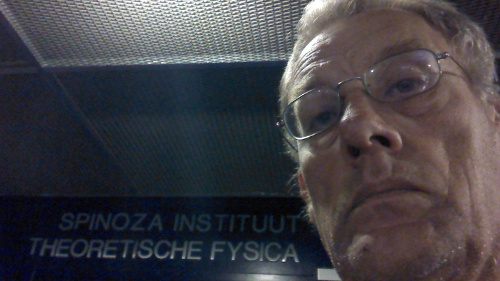
... I thought those would be two different institutes ...
Behind this door, I expected to find two
entirely different institutes, for 17th century Spinoza, though a renowned grinder of very
good lenses, simply copied his physics from Descartes (while at the time Newton recently
had become available in Holland). I simply could not believe somebody would name
a physics institute after Spinoza, of all people. In Spinoza's Cartesian view
the universe is totally filled
with a dust of very fine particles. There is no gravity. Dust particles push each other
round to
form kind of twisters, small and big. Those dust particles, Descartes held, pushed the planets round en kept pushing
us against
the earth's surface. I studied Spinoza's take of this in his Ethica
while making the now widely used Spinoza Ethica Help Web.
[my vicissitudes while making: Spinoza].
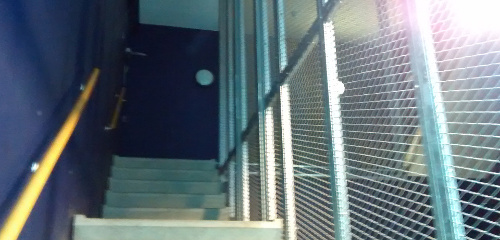
... trotting up: police arrest wing colours and hardware ...
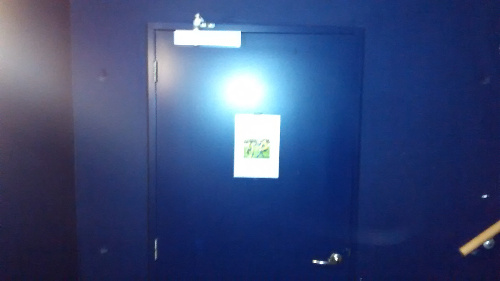
... blue darkness, blind doors ...
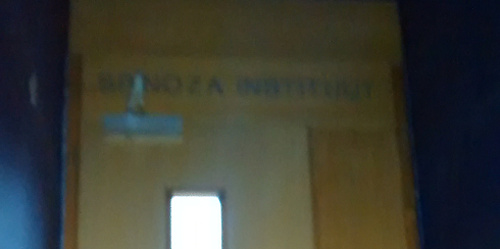
... Top floor: only the Spinoza Instituut, where's Theoretical Physics
Institute? ...
Behind that door I suddenly was in a bright comfortable top floor
unit with lots of roof light. A top research institute in ... physics. Spacy
light rooms. In some, people were typing, in others two or three were
talking matrices, tensors, equilibria and filling wallboards with wide
gestures. One thing was clear: if I would be given a desk here and allowed to
ask any question arising while studying relativity, I would be done in a few
days. The other: I did not belong here. These guys and girls were too good. All
around thirty, no
Dutch people either, except for the manager who kindly named
the building
to me where they know all about bachelor teaching.
Thank you.
Would not want to have missed this short digression.

... Homing in on target, my foldable bike did not mind me to stay away long ...
The "Buys Ballot" building was surrounded by bicycles! I
told reception
staff there was a physics course I could not find. They tried, did not find, but knew the room number of Els, the planner of
physics courses. Els gave me all data of my mechanics course, and an efficient staff web
address (not linked to from the university's home page) to
find those data next time.
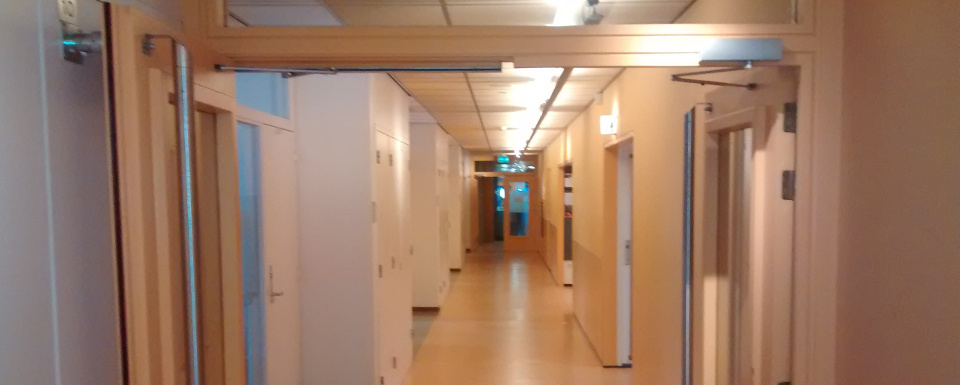
... reception knew Els' room, she helped me out ...
Not long after I had returned home, my schedule sported signs it had not
seen for 16 years (though blue is
12footdinghy competition sailing):

... Last
time my schedule sported this type of shit was December 1999 (but then even
worse: as a lecturer) ...
They had already started some weeks ago, but classical mechanics
(Newton, Kepler) had been done as well, most of which should be familiar to me.
So, the next Monday morning my alarm clock unchained me, I arrived
early, students told me what books and what lecture notes were used, and what is
the floor and room
number of the physics student's association that sells them.
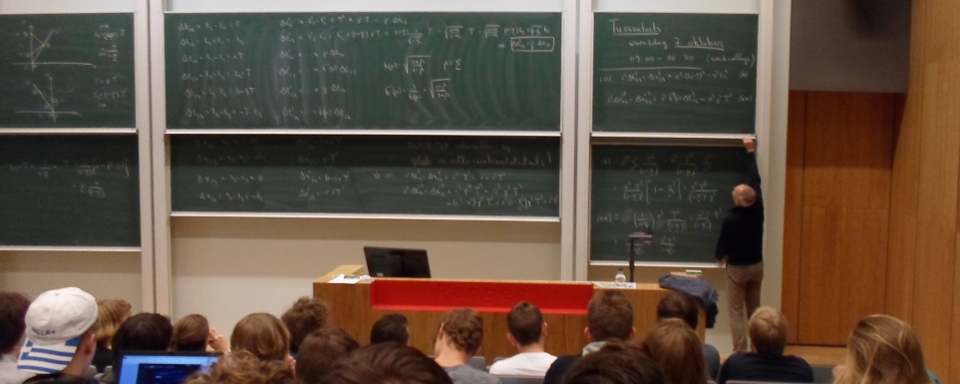
... this is serious!
...
There I sat, taking chalkboard shots every one of which seemed to
require hours of work at home. Students are updated by a digital "blackboard"
(forcing me to rename the analogue one to "chalkboard", but that's a better
label anyway). For the digital "blackboard" you need a login, the end
of the university as a public institution, we are now just another commercial
shop. Well, no need. By now I should have enough. The login
protected digital blackboard made me realize why my search for my target had been a bit
erratic: I had accidentally taken an unused inroad over a campus security
officer, muscular Arab receptionist, Spinoza and Els. Thus
circumventing the
university's web welcoming page's "virtual sleeping coach" and "anti-teasing
program", I inadvertently managed to squeeze my rather
oversized body
through an unmonetized mouse hole entrance of the theatre! I saved a value of at least some sizeable boxes of excellent Cuban
cigars,
very agreeable smoking while, as I would soon start to do, covering paper with math.
150 audience or so. Astronomy and physics bachelors. Among these 17 and 18 year olds there were quite some Asians.
But a surprising lot of Arabic and
Turkish students, native speakers of what unlike Dutch are world languages
(Arabic 300x106 speakers, Turkish 200x106, until deep in
Siberia and China). These
brightest children of what the Dutch call "backward quarters" abound
all over the university's beta quarter - good idea: if you learn
something too difficult for others you can't be discriminated against. Let the
Dutch youth study "management" whatever that may be. But everybody
there perfectly understands the Dutch of Flemish teacher Professor Stefan Vandoren,
engaged in translating the English lecture notes of his predecessor De
Wit back into real Dutch. I saw De Wit's English version of the lecture notes in
some student's hands.
Ok. Dutch. Our midget German dialect on exit,
as some say? Dutch physics terms are sometimes badly chosen and
confusing: impulse is called "stoot", momentum is called "impuls", they
also use the word "moment". It means torque.
They use "dilation" and "dilatation" in a random mix. A murky mess, like Dutch
language generally, historically indeed pidginized German.
Dutch physics at first had nothing to do with it for it proceeded in Latin. The problem arose when deep in the 18th century
The Netherlands got in unbelievable decay, chickens and their shit all over the
place, Latin started to wane at Dutch universities
and nitwit physics professors on hunger wages started to copy physics from Latin into Dutch language.
That was the period in which foreigners started to say "in
The Netherlands everything happens 50 years later". But
today the Rhine wetlands are
catching up again: surely fifty years from now under the management of our
immigrated talent, we shall be top of the heap and Dutch language will be
in the league of Frisian and Lower Saxon (=Plattdutch, a pidgin German rival of
Dutch but spoken from Groningen all over Northern Germany to Riga, 76x106
speakers): abolished for all serious purposes (how's that from me, I'm half Frisian, half
Lower Saxon).
But where was I? O yes:
so, I longed for De Wit's English, but, ... not sold anymore by the
students association, only on the "blackboard". OK shit happens.
By far most
students were white and
Dutch, clearly from all strata of society: here selection had been on brains
only! What a relief hearing all these youngsters talking functions and equations in the
intermission instead of the ordinary adolescent Facebook bullshit.
The week after, also an African young man
joined and sat next to me. By way of
test, I pretended not to understand a fairly simply thing and asked him.
After a silence of a length that made my sweat break out he said:
"... yes I also found that a bit odd ..."
I: "Well, I believe it is correct, I just do not understand why"
He: "Yes, I'll have to look at that too".
Not the surprise I hoped for (I live in Africa now for 12 years
[more] and
have closely worked, often as the only white, in
groups of Africans on many different issues from
language analysis to
shipbuilding).
I asked the fat rosy white acne ridden highly +-dioptric adolescent at my
other side who swiftly produced the explanation.
I turned to my black neighbour
again: "Have you heard?"
He hadn't. Managed to wheedle a scholarship off a European philanthropist?
That's what they're damned good at ... anyway, postman soon.
Professor Vandoren is an entertaining
teacher. He is not copying
a sheet of formulas on the chalkboard but starts calculating
right in front of us.
Live calculation! As a jazz player [more] I know how you enhance your
connection to band and public by NOT putting a score
sheet in front of you, here it was the same! And more: when
you make a truly live mistake there is no disappointment. It shows how difficult
the subject is you are about to master! A mistake,
especially one that blocks the proper outcome and leads to Vandoren taking distance
from the blackboard, silence, hand at chin in frantic
scanning of the rows of symbols, sends a
shivering through the smart part of the audience. Then someone sets out to help
him. But he's wrong. "No that cannot be the error", Vandoren explains calmly "because if you look
here, these two ..." Now the crowd is at peak concentration! Another student
discovers somewhere a c2 copied to c1.
As for intensive
and successful teaching, nothing works better than the tension of an error on
the chalkboard.
Vandoren looks, corrects, looks back, laughs and says. "Sharp!".
Looks back to the board and back to the student, says again: "Very sharp".
Lesson #1 to
the freshman and -woman:
there is never need for shame.
At another calculation derailment Vandoren judged he was loosing too much time
"... I think I did not go the easiest way ... anyway you should be able to do
this at home ...", looks again to the blackboard, clearly nervous, finds the
error, quickly writes the result and says, with a shy smile: "... yes when everybody is
looking at you, it sometimes is less easy to get out ...".
Important lesson #2:
you may feel shy, but you don't give up!
How's that for a teacher! Never seen that! I myself know that
situation when lecturing, but never could smile getting in and out of
trouble on the blackboard - excuse me chalkboard. Now I have Vandoren's example, I could do it but fortunately
my savings made my sentence to academic teaching expire long ago.
Home with the 4 euro 23 cents or so Flemish teaching doc "Special
Relativity Theory" and a fairly cheap thick English physics text book bought in the physics student's association room.

... Back to my heavenly solitary
riverside home with the teaching docs ...

... On
September 28, 2015, I starting filling my dustbin with math-covered paper ...
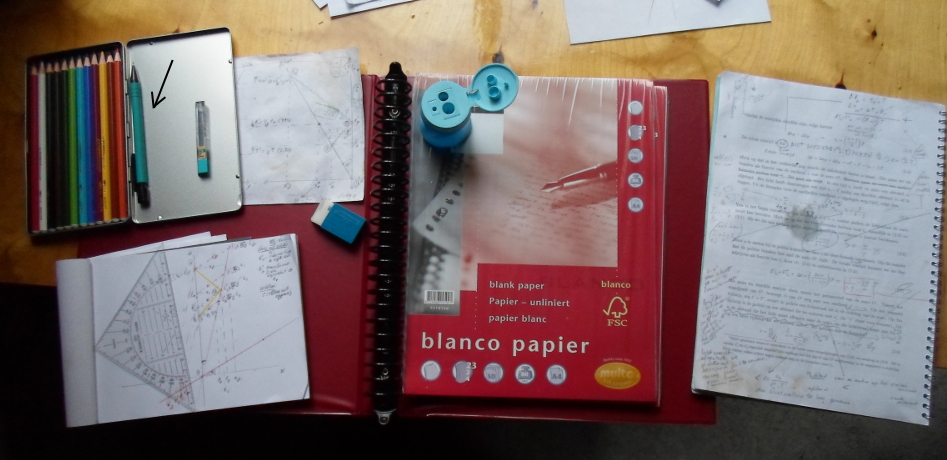
... my old habits revived: non-digital hardware use ...
Since I last used non digital studying hardware twenty years ago (I lost my
last books and paper notes in a
tornado on Lake Victoria, without much regret: after all it's all on internet now) the quality of colour
pencils has
risen, clickable ring binder handling has become even more comfortable, pencil sharpeners
have further improved, geo-triangles are thinner and more flexible and there still
is replacement filling for my beloved graphite pencil (left at arrow) I
kept on me for over 15 years living in the
Alps, Africa, and wandering with my
Kangoo microcamper from
Inverness to
Marrakech.
After some weeks of Utrecht lectures my despair, frustration and agitation all
peaked. Little did I know, immersed as I was in trying to follow the Utrecht version of the
relativity story, that what Vandoren told on the
very first lecture already implied that Einstein's pen made a small slip
where he wrote in Anhang 1, to explain that graph reproduced above : "längs der negative X-Achse sich
fortplantzenden Lichtstralen", while he clearly means "sich in negative
Richting fortplantzenden Lichtstralen" (which can be along the positive x-axis
too!). If he had
written the latter, which clearly is what he had in mind - it's just a
slip, no wonder when you have explained it a thousand times - I would never have
considered to go to those Utrecht physics lectures.
Another proof of my observation above that nothing boosts progress more than errors. Thank you Einstein! No way to sniff out that slip when
you do a first
relativity theory reading, like I did. And when the stuff to sniff it out came along in Utrecht,
I failed to notice, since I had laid
Einstein's booklet aside in utter disappointment after even checking the Dutch
translation, which had literally copied the slip ("lichtstralen
die zich langs de negatieve x-as voortplanten"). So I thought: this looks crap
but he's serious, so
I need a live teacher.
In the meantime the Utrecht exposition had
begun to firmly blur my brains on other unrelated issues ... How long would it
take before I would get the idea to turn back to Einstein's little book and see
that Vandoren in the first 10 minutes I heard
him had given the stuff needed to understand what had blocked me in Einstein's
derivation of the Lorentz
transformation en read on from there?
Clearly, since its forst appearance 1916, nobody can have understood the Lorentz transformation from Einstein's
little book or its Dutch translation except those who somehow understood this
"negative X-Achse"-thing was
a slip of our hero's
pen (details).

...
Brain-blurring physical reasoning ... Help! This guy is CRAZY!!! ...
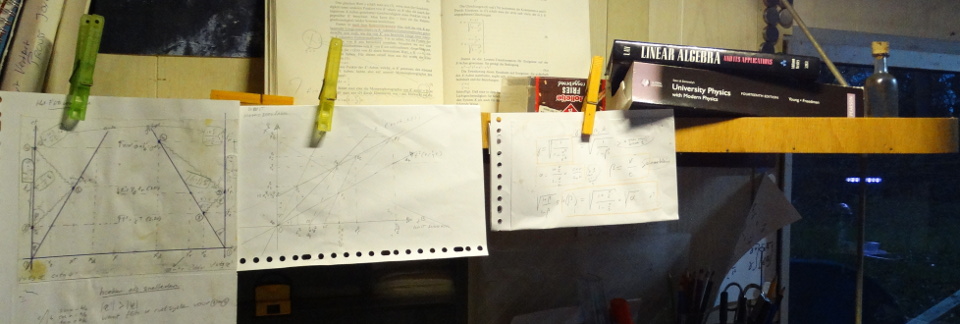
In those weeks of desperate and frustrated search I noticed myself starting cooling my rage on ordering everything else
around me! Ridiculous,
but I could not stop myself.

... cooling rage on
hardware order ...
First the pencil box, then the rest of the shelf where it stands (up-left in
picture), then the
opposite shelf with its hardware boxes (up-right), then an ergonomic lighter
suspension (down left,) then my coffee making system (down middle), finally
introducing a pill box to put 7 of my one-a-day pills on Monday and
sync day-awareness with that of whether I took my pill ... all to no avail of course:
the shit was in my brains.
And
I had headaches. Literally. I NEVER have headaches.
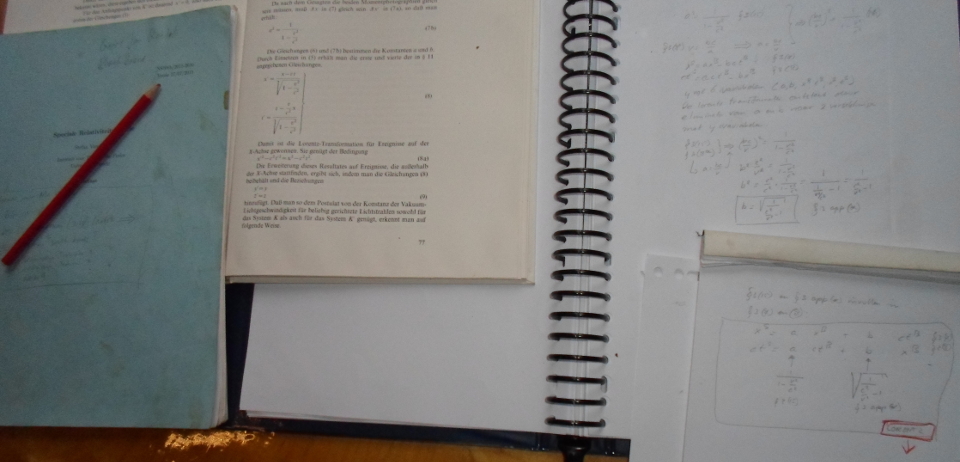
... Finally it was Einstein's 1916 explanation to the educated general
public (middle) who made me understand the Lorentz transformation ...
It took three weeks of filling my dustbin with papers full of graph and formula
trials. But then, on October 22, 2015, after almost a full month of
wandering through a dense forest in circles, I was desperate enough to
draw Einstein's little book from the shelf again. Only then I realized that Vandoren's
take implied this "negative Achse"-thing should be a
slip, could I read on. In Einstein. That same afternoon I understood
the Lorentz transformation.
I wrote it down too in Bert
Reads Einstein [math] and [exercise]. There,
unlike Vandoren-De Wit, I first completely prepare the Lorentz
gymnastics-floor following Einstein's exposition [math] , After that is clear, Vandoren's illustrative
examples and exercises are of great help to turn your first successful relativity
moves into a smooth vegetative routine of relative time and distance measurement.
Acquiring that is more like coming home with a
new scale for your musical instrument en start playing it. Sounds rusty at first
and will take weeks of daily exercise
to get smoother. It did: [exercise].
Meanwhile I had spent roughly the equivalent of a reasonable tuition fee on
Cuban cigars, and shall have to gear down the addiction by means of a week of
abstinentia.











